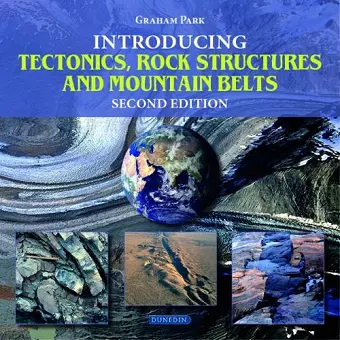Introducing Tectonics, Rock Structures and Mountain Belts
Format:Paperback
Publisher:Liverpool University Press
Published:25th Mar '21
Should be back in stock very soon

Introducing Tectonics, Rock Structures and Mountain Belts is written to explain the key concepts of tectonics and rock structures to students and to the interested non-specialist, especially those without a strong mathematical background. The study and understanding of geological structures has traditionally been guided by the rigorous application of mathematics and physics but, in this book, Graham Park has avoided mathematical equations altogether and has reduced the geometry to the minimum necessary. The application of plate tectonic theory has revolutionised structural geology by giving the study of rock structures a context in which they can be explained. Since the large-scale movements of the plates ultimately control smaller-scale structures, the study of tectonics is the key to understanding the latter. The reader is thus introduced to large-scale Earth structure and the theory of plate tectonics before dealing with geological structures such as faults and folds. Studies by structural geologists of the movement history of rock masses relative to each other, as revealed by the study of fault systems and shear zones, has helped to integrate rock structures with plate tectonics and this has been emphasised in the book. One of the most exciting aspects of geology is the study of the great mountain ranges, orogenic belts. The final three chapters of the book explain how knowledge of plate tectonic theory, geological structures and the processes of deformation may be employed to understand these orogenic belts. hilst excessive use of terminology is avoided, all technical terms are in a Glossary and, as with all books in this series, the text is illustrated profusely.
‘This is a great little book that provides an introduction to earth structures on a wide range of scales, starting with the structure of the Earth and plate tectonic theory. This is then used as a context in which to look at deformation, fractures and faulting, folding, and fabrics such as schistosity and gneissosity. The final few chapters of the book are dedicated to orogenic belts, both modern and ancient, showing how a knowledge of structures can aid our understanding of these exciting regions.
The author, Graham Park, is Emeritus Professor of Tectonic Geology at the University of Keele. He has deliberately steered away from a textbook containing a rigorous mathematical approach to the subject of structures, and has instead kept the geometry to the minimum required for the concepts to be understood.
The book is well illustrated, both with schematics illustrating the concepts, and a wide array of colour photographs showing field examples, all of which are well referenced in the text and aid understanding of the structures described. There is also an excellent glossary, which is handy as a quick reference for structural terms.’ Proceedings of the OUGS
‘Now in an updated second edition, Introducing Tectonics, Rock Structures and Mountain Belts emphasizes large- scale geologic structures and plate tectonic theory. Full-color photographs and diagrams on almost every page, as well as an extensive glossary, help make Introducing Tectonics, Rock Structures and Mountain Belts accessible to readers of all backgrounds. Introducing Tectonics, Rock Structures and Mountain Belts is a choice pick for high school and public library science collections, as well as for anyone interested in this fascinating branch of science about the not-so-solid Earth beneath our feet. Highly recommended!’ Mid West Book Review
ISBN: 9781780460949
Dimensions: unknown
Weight: 457g
152 pages
2nd Revised edition